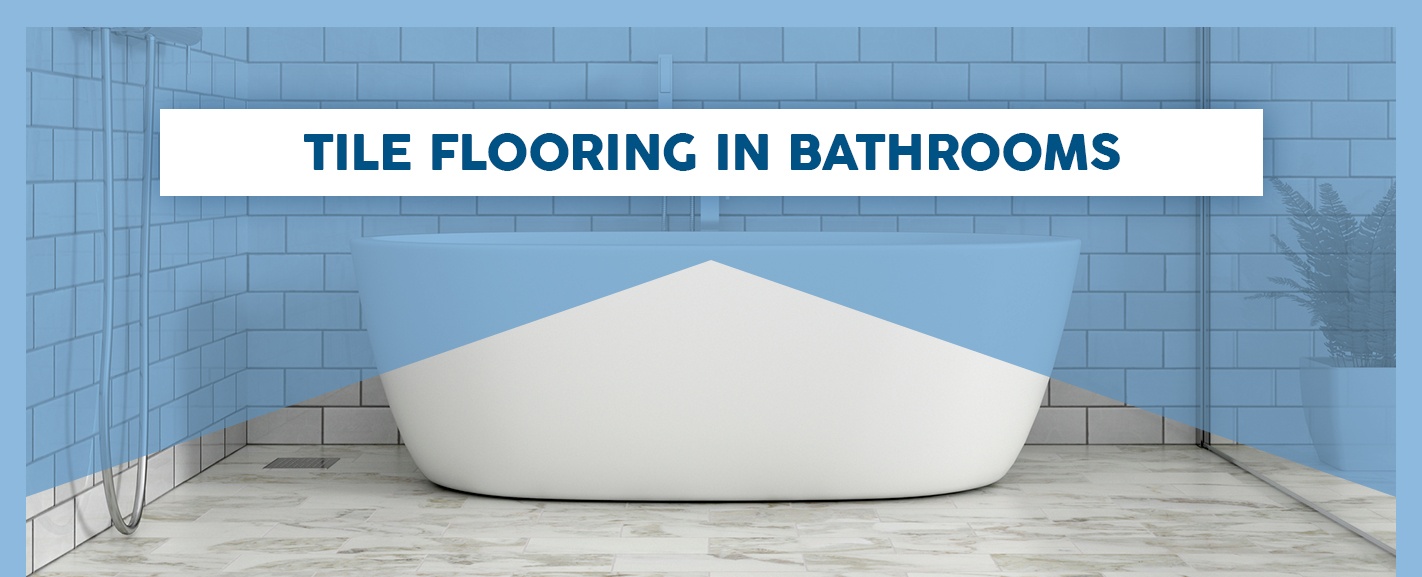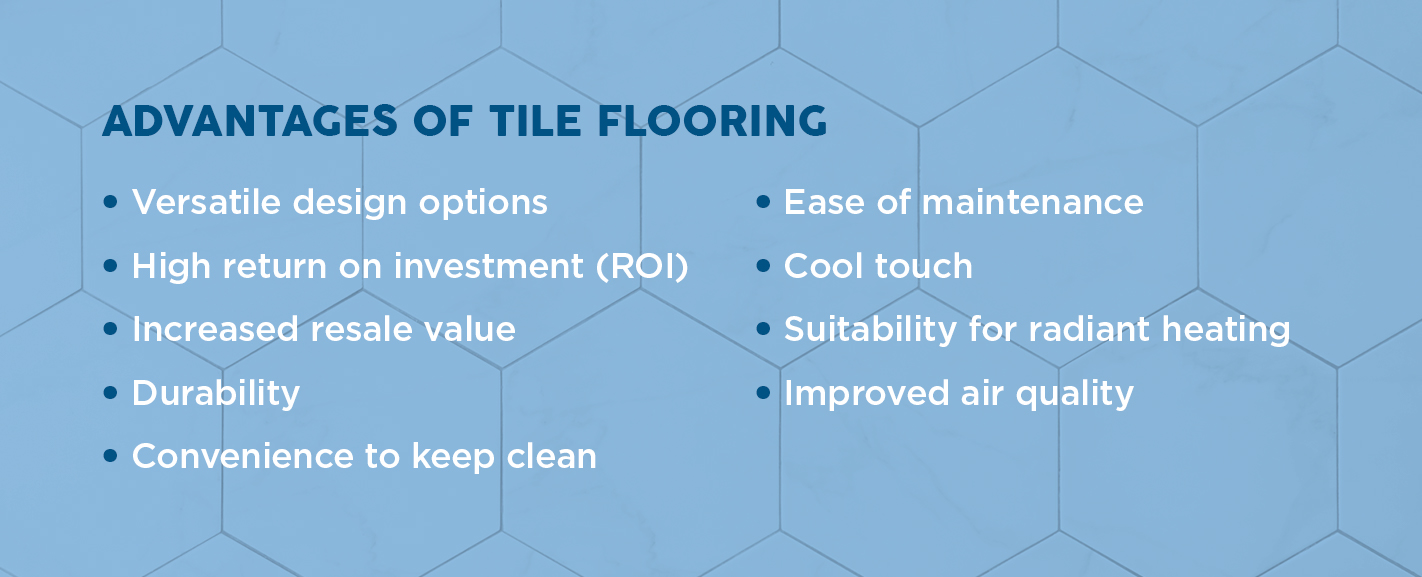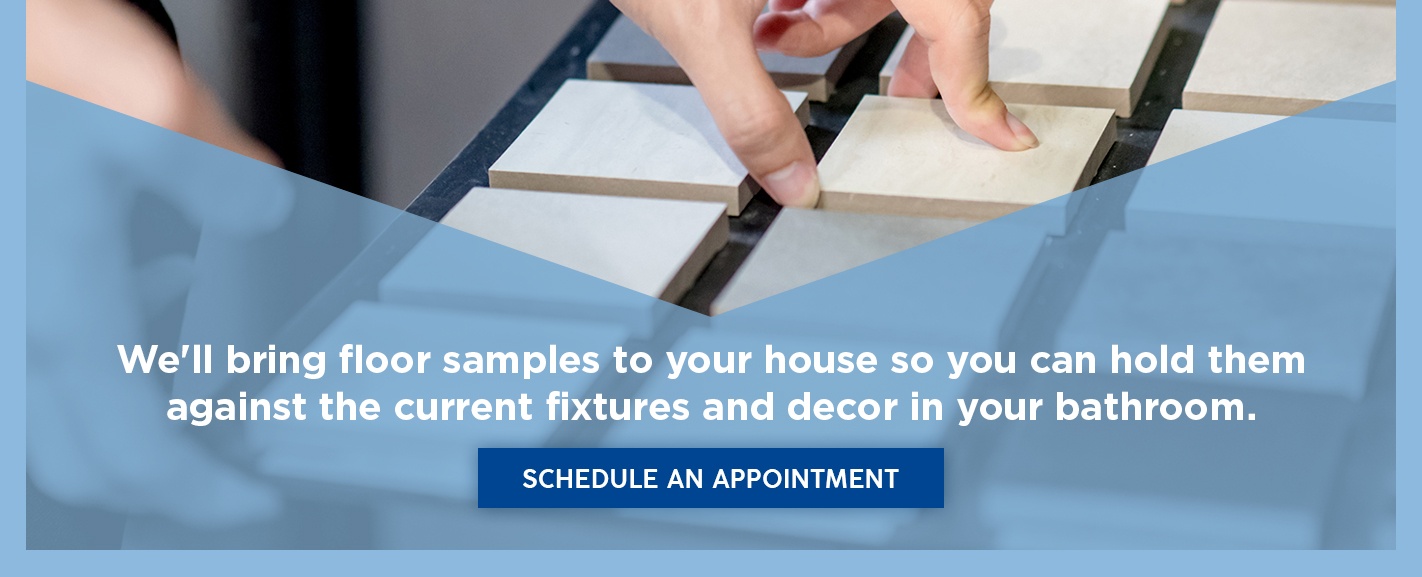
If you’re thinking about renovating your bathroom, high-quality, low-maintenance tile is your best flooring option. Bathroom floor tile is usually porcelain or ceramic, and builders have used it in residential and commercial properties for thousands of years. Here are some of the reasons why you should have tile flooring in your bathroom.
View Flooring Options by Room
History of Tile Flooring
Even though homeowners have favored tile flooring for centuries, the material has been around for thousands of years. The following ancient civilizations all used tile flooring in their architectural design:
Ancient China: Ceramic clay pottery originated in Chinatens of thousands of years ago. The Chinese created ceramic pottery and painted amazing images on white porcelain tiles. Throughout the dynastic periods, artisans developed the quality and mass production of porcelain for architectural use.Ancient Egypt: The Ancient Egyptians incorporated stone and ceramic tile flooring in their pyramid architecture and other impressive structures. Egyptian tile was originally ceramic clay that they let bake in the hot sun. As the process developed, manufacturers began using early kilns to make tiles. The Egyptians may have been the first to createceramic floor tiles through kiln firing.Ancient Greece:Greek tile floors featured mosaic patterns that have become the style for Mediterranean homes and temples. Even though marble and travertine were standard in Ancient Greece, artisans also used ceramic. Many mosaic tiles from thousands of years ago are still in ancient structures today, proving the material’s durability.
Types of Tile Flooring for Bathrooms
The two primary tile materials for the bathroom are ceramic and porcelain. Both types of tile can resemble natural wood or stone, and they come in various colors and patterns to enhance your bathroom’s aesthetic. Learn about each tile material’s characteristics to help you decide which one is more suitable for your living space.
View Flooring Options by Room
Ceramic
Ceramic tile is a popular choice for bathrooms because of its versatility, durability and price. This material is easy to maintain and repair, and it tends to be less expensive than most other flooring materials. Glazed ceramic tiles resist moisture absorption, scratches and stains. The flexible design options allow you to create the exact flooring you want at an affordable cost. You can find ceramic tile that resembles natural wood or stone, both of which can accommodate many design aesthetics from farmhouse to mid-century modern.
Porcelain
Porcelain is a type of ceramic with a lower water absorption rate, making it more resistant to water damage. This material is typically higher quality than standard ceramic because it contains a higher silica and quartz ratio. Since manufacturers usually bake it at a higher temperature, porcelain is durable against heat and other wear and tear.
Even though porcelain is slightly more expensive than ceramic, it’s more affordable than natural stone or hardwood flooring. Like ceramic, porcelain is available in many color and pattern options. Texturized, glazed and etched porcelain tiles can look like brick, hardwood or marble. It has a through-body color, allowing it to maintain its appearance if chipping occurs.
dvantages of Tile Flooring

Consider some of the following benefits of tile flooring for your bathroom:
Versatile design options: Tile is available in various materials, colors, sizes and textures to accommodate the style of your bathroom. It can resemble natural wood or stone, and it comes in different shapes and sizes for unique visual effects. Pairing your tile with the right grout colorwill enhance your floor’s visual appeal.High return on investment (ROI):Since porcelain and ceramic tile tends to be more affordable than other flooring materials, it can be a better investment for your bathroom. When you spend a little bit of money on a long-lasting flooring material, you can save money over the years on future replacements.Increased resale value: Tile flooring in bathrooms usually raises the value of your house when it’s time to sell it. An attractive floor tile may look like a luxurious stone or wood at a fraction of the cost, and most potential homebuyers won’t mind that your flooring is a cheaper material.Durability: You should get tile flooring for the bathroom because of its resistance to water damage and everyday wear and tear. Since your bathroom features several water sources, you need a material that can withstand humidity and moisture. Besides water resistance, tile flooring also won’t discolor from soaps and messes. If you have kids or pets in the house, you don’t have to worry about them creating permanent stains on your bathroom floors.Convenience to keep clean: Since tile is resistant to water damage, you can easily use a wet mop to wipe up stubborn grime. For regular cleaning, it’s best to use warm, soapy water and a soft-bristled brush. However, you can also use bleach todisinfect your flooring surfaces.Ease of maintenance: If you find a cracked tile on your floor, you can easily replace the tile in a matter of minutes. Your flooring specialist may recommend keeping an extra package of tile on hand in case of future breaks. When you usehigh-quality grout, you can make your tile flooring even more convenient to maintain and repair. Grout usually prevents water from leaching underneath the tile and damaging the subfloor.Cool touch: Tile flooring possesses exceptional cooling properties to keep your bathroom comfortable in the summer. Its hard surface transfers heat out of the room to maintain comfortably cool temperatures.Suitability for radiant heating: Even though tile flooring can keep your bathroom cool in the summer, you can also install radiant heating under the tile to make your floors cozy in the winter.Improved air quality: Since tiles form at high temperatures, manufacturers can avoid using volatile organic compounds (VOCs) to create them. VOCs can contribute to many health problems, but having fewer contaminants in the house can help make the air more pleasant. Ceramic and porcelain tiles alsodon’t trap irritants and allergens, so you and your loved ones can breathe safely.
Disadvantages of Tile Flooring
To make an informed decision about your bathroom floors, you might want to consider the drawbacks of tile flooring:
Cold for your feet:This quality is desirable in the summer, but in the winter, you’ll want to wear socks in the bathroom. Leaving a warm shower to touch your freezing tiles with bare feet can be shocking and uncomfortable. However, when you install radiant heating under your floors, it can make your tile flooring more comfortable all year long.Hard to walk or stand on:Since tile is hard, it can be challenging to stand on for a long time. Those with bone and joint conditions, such as arthritis and osteoporosis, can suffer from joint and muscle fatigue when walking and standing on tile flooring for too long. You can lay down comfortable padding in front of your sink to provide comfort during your morning or nightly routine.Slippery when wet:Wet tile flooring can be unsteady, so it may be dangerous in your wet, humid bathroom. However, your local flooring specialist can texture them properly to prevent slips. You may also want to consider smaller tiles that feature more grout, which can guard against skidding.
Schedule an Appointment With 50 Floor for New Bathroom Flooring
When you’ve decided on new bathroom flooring, you can schedule an in-home appointment with us. We’ll bring floor samples to your house so you can hold them against the current fixtures and decor in your bathroom. For more information about our high-quality products and installation services, call us at1-877-50-FLOOR.
View Flooring Options by Room

The post Tile Flooring in Bathrooms appeared first on 50 Floor.